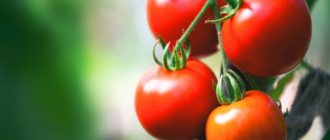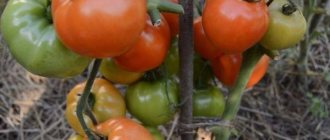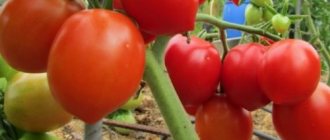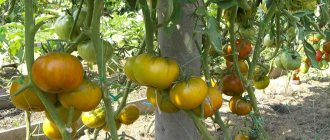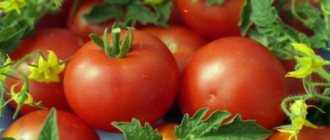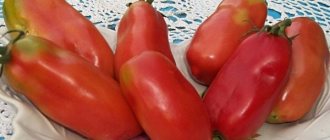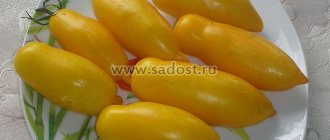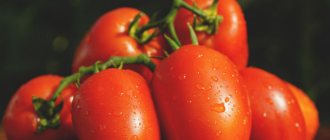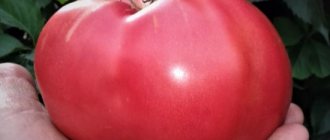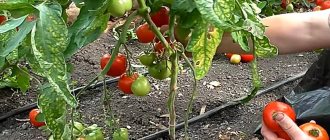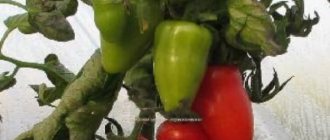For those who want to get to know the fruitful variety better, modern selection has prepared Tamina. The cultivar was bred in Germany. The highlight of the variety is its high productivity, unpretentiousness and excellent durability.
| Height | Landing location | Ripening time | Fruit color | Fruit size | Origin | Fruit shape |
| Tall | Greenhouse, Open ground | Early ripening | Reds | Large | Variety | Flat-round |
Features of care
Experienced summer residents who have been growing Tamina for several years claim that the plant does not require complex care. However, you need to adhere to standard procedures necessary for good plant development and fruiting:
- Timely watering.
Tamina loves water, so dry periods are unacceptable. - Loosening the soil.
Regular loosening of the soil will provide access to moisture to the root system and prevent the development of microorganisms dangerous to the plant. - Feeding.
The entire period of tomato growth is fed with both mineral and organic fertilizers. - Removing weeds.
Weeds can cause soil acidification, which is dangerous for the crop. - Treatment with biostimulants.
Biostimulants will ensure active plant growth and ovary formation. In addition, they can have a positive effect on fruit ripening and increase the amount of harvest. - Stepsonning.
The plant needs pinching. - Garter.
An adult bush needs to be tied to a support. Otherwise, the plant may break under the weight of its own fruits. - Timely harvesting of fruits.
Ripe fruits that remain on Tamina's branches take a lot of strength and prevent the development of new ovaries.
Gardeners who grow the Tamina variety say that it is impossible to refuse to grow it. Fast ripening, minimal care and a high-quality, rich harvest make you return to planting these tomatoes year after year.
Watering, fertilizing
Caring for seedlings consists of regular watering, two feedings (1 teaspoon of nitroammofoska per bucket of water) and prevention of late blight with fungicides. Water it once a month with a pink solution of potassium permanganate. In hot weather, you need to ventilate the garden under glass during the day. The seedlings will be hardened and will not stretch.
- The seedlings are first treated three weeks after planting, the second time twenty days after the initial treatment, and the last time after the third cluster appears on the bushes.
- It is possible to feed the plants during the period of active growth with a solution of slurry or bird droppings. The bushes do not require formation, removal of stepsons, or tying up. In rainy weather, plants are treated with growth regulators and stimulants.
- Irrigation in the first month is carried out so that the top layer of soil is kept moist. Caring for tomatoes consists of weeding and loosening the soil around the plants.
- The more often you loosen, the larger the pomona gifts will be. The variety responds well to fertilizing, especially liquid fertilizing. Feed 3 times with an interval of 12 days. Mullein is used as a fertility granule. Add one tablespoon of ammonium nitrate to a bucket of solution, using it for 10 square meters of land.
- The second feeding is carried out with mineral fertilizers. Until now, feeding should be stopped when mass formation of ovaries occurs. If you do not stop fertilizing the plants, there is a danger of provoking compulsory leaf growth. The only benefits at this time are soil cultivation and moderate watering.
- In wet weather, plants are affected by powdery mildew, which is why they are treated with stimulants and growth regulators.
It is recommended to pile Bochata tomatoes in a state of technical ripeness. The fruits are well transported over long distances, have the highest brand presentation, and are in great demand among buyers.
With the help of the simple recommendations described in the article, you can get an early and rich harvest in your greenhouse.
Description of the Lopatinskie tomato, advantages of the variety and agricultural cultivation techniques
Each vegetable grower chooses nightshade varieties to suit his own taste; many prefer large-fruited, high-quality ones such as the Lopatinskie tomato. Despite the fact that there is an opinion that fairly large tomatoes have a lower quality of taste, this variety is very popular and completely refutes these assumptions.
The Lopatinskie tomato variety has excellent reviews from those who grew it on their plots. It is characterized as a hardy and strong plant that is not susceptible to many fungi, is resistant to weather vagaries and always produces a high yield.
You can grow Lopatinskie tomato varieties in open ground, a greenhouse or a greenhouse. The plant tolerates temperature changes well and does not tolerate prolonged drought.
Advantages of the variety
The variety description includes the following information:
- Lopatinsky tomatoes are an indeterminate species. The bushes reach a height of 0.8-1 m. An adult plant needs additional support and garter, as the tomato grows and develops in the form of vines.
- Requires formation into 2-3 trunks. This will help increase yield and affect the quality of tomatoes. Gardeners advise planting the plant, which will increase the number of clusters.
- The variety is mid-season, the first fruits appear 115 days after the first shoots.
- The bush has a strong root system. The leaf mass is dense and large. The branches are long and wide, often lying on the ground. They need to be tied up.
- The plant is hardy and unpretentious in care, easily adapts to weather changes without dropping fruits. Those gardeners who grew this tomato note that it is unpretentious to the soil, but needs regular fertilization.
- This type of tomato is resistant to late blight and tobacco mosaic. Requires protection in the form of spraying against pests.
- The yield of the Lopatinskiye variety is excellent. 10 kg of tomatoes are harvested from 1 bush per season. The bushes bear fruit for a long time, almost without interruption.
- Tomatoes are stored for about 1-1.5 months. They ripen well when semi-ripe. Gardeners prefer to pick them at the ripening stage, when the tomatoes acquire a milky color.
- The Lopatinskie tomato variety requires regular watering during the period of fruit formation. This is due to the mass and volume of the tomato.
- Taste qualities are assessed as high. Tomatoes contain a sufficient amount of sugar and dry matter and have a bright tomato aroma. The taste is pronounced, the acid is moderate.
The Lopatinskie variety is suitable for universal use. The housewife who has already planted these tomatoes in her garden appreciates their quality and says that I am planting and will continue to grow them.
- The fruits are large. If agricultural technology is followed, the weight of 1 tomato reaches 700-800 g.
- The tomatoes are round in shape, but slightly compressed at the top and bottom.
- The color is deep red. There are inclusions and barely noticeable stripes of a light yellow or green hue extending from the stalk.
- The tomato pulp is dense, juicy, and contains several chambers with small seeds.
- The peel is dense, but easily removed from the fruit.
- The fruits are smooth with noticeable ribbing.
- Suitable for long distance transportation.
- Tomatoes ripen gradually. About 4-5 large fruits are formed on 1 cluster.
Agricultural technology of tomatoes
Tomatoes are grown in seedlings.
Sowing is carried out 60-65 days before planting in open ground or a greenhouse.
Before planting, seeds must be disinfected with a weak solution of manganese. They are soaked in the composition for 30 minutes, after which they are laid out on a sheet of paper and dried in sunlight. Before planting, you can use a growth stimulator.
The soil for seedlings must be nutritious, so the soil should be mixed with peat and sand. All components are taken in equal quantities.
The seeds are deepened into the soil 2 cm and immediately watered with warm water. The box with planting material is covered with polyethylene and stored in a room with a temperature not lower than +20°C. As soon as the first shoots emerge, the film is removed and the box is transferred to the light.
It is important for young shoots to be warm and receive plenty of sunlight. Picking is carried out with the appearance of 2 leaves on the sprouts
How to plant and care properly
You need to sow Tamina tomatoes for seedlings two months (at least 50 days) before they are planned to be planted in open ground or in another permanent place. Seeds germinate best if they are provided with the optimal temperature for this, between 23 and 25 degrees Celsius.
When the time comes to plant seedlings in the ground, you need to maintain the distance between the bushes - one square meter is optimal for placing three adult plants, and you need to focus on this indicator.
An adult tomato of the Tamina variety requires pinching and staking; the bush can grow into one or two stems. The stems are dense, and the leaves resemble potato leaves. The plant has a good response to watering; it likes it when fertilized with complex mineral fertilizers.
Plant growth and development stimulants, which are specially designed for these purposes, are positively perceived by this early ripening variety. They improve not only seed germination and stem health, but also have a positive effect on fruit set and their yield. It is recommended to use such substances; they will be especially useful for beginning gardeners. They are popular with those who grow tomatoes for themselves and for sale, as they are unpretentious to environmental conditions.
We can say that planting Tamina tomatoes gives an almost 100% guarantee that the summer resident will soon have tomatoes.
These tomatoes are practically unaffected by drought and diseases common to such vegetables, so that in any summer the agricultural technician receives a good yield of tasty tomatoes with dense pulp.
An additional advantage of the variety is that the fruits are undemanding when it comes to transportation: the tomatoes almost do not wrinkle or burst, except with very rough handling. The fruits have a very long shelf life.
source
Tomato Matador
Article: absent
Notify about arrival
- Plant height: 35-45 cm
- Ideal for canning
- Used fresh
Seeds meet requirements
international standards and GOST RF 12260-81
Does not contain Genetically Modified Organisms (no harm to health)
ACCEPTING ORDERS: All year round
SHIPPING orders: All year round
For whole fruit canning
An early ripening hybrid variety. The bushes are of a determinate type, quite compact, barely reaching 60-75 centimeters in height. They are overgrown with medium-sized green leaves that have a shape characteristic of nightshade crops. Simple inflorescences are formed on the plants.
The smooth, cylindrical fruits are relatively small, green at the stage of immaturity, and when ripe they become distinctly red. They have a pleasant taste with a slight sourness. Suitable for various culinary uses. Transportable. The variety is suitable for industrial cultivation.
Resistant to Alternaria and tobacco mosaic.
Agricultural technology
- It is aimed at cultivation in open soil, but is also suitable for greenhouses or temporary film shelters. Prefers light loam or sandy loam, which has good air permeability, is rich in humus and nutrients necessary for plants, always in non-shaded and non-leeward areas. Growing usually occurs in seedlings. Sowing into seedling containers is carried out on March 20-30, transferring to beds on May 15-25, according to the 60x30-40 cm pattern.
- For the entire growing season, seedlings of this variety need sufficient sunlight. If the crops are too dense, thinning is necessary. Bushes rarely require tying up. Seedlings need 60-65 percent air humidity until 10-12 weeks of age, and after that - 50-60 percent. Other measures include regular watering to keep the beds moist, loosening for aeration, and periodic fertilizing.
- Tomatoes of this variety will have to wait 105-115 days for ripening from the moment the seedlings peck. The estimated harvest time is July to mid-August. The yield indicators are excellent - up to 32-45 tons per hectare. The fruits, which usually reach a weight of 75-100 grams, are distinguished by their high shelf life.
Tomato "Apple tree of Russia". Characteristics and description of the variety
- general description
- Agricultural technology. "Apple Tree of Russia"
We will consider the tomato “Yablonka Rossii” and the description of the variety today. Summer residents post photos and reviews with pleasure, because tomatoes really deserve everyone to know about them. Meet you too.
general description
As you already understand, “Yablonka Rossii” is an early-ripening tomato, and this is its strong point. After all, you get organic vegetables at the beginning of summer, eat them throughout the entire summer season, and besides, early species are rarely attacked by insects, which are especially active in July.
The variety was created by Russian breeders quite a long time ago - in 1998. It showed itself very well when grown in different regions and even where the climate is not pleasant with its warmth. You can grow a tomato both outside and in a greenhouse, and the fruits will be equally tasty. In addition, the tomato does not require special attention and can save your time due to its qualities. Why is this variety so good? Read on.
Tomato "Apple tree of Russia". Characteristics and description of the variety
- It has early ripening periods - you will receive the harvest 90-105 days after sowing.
- The bushes are of a determinate type, that is, they are limited in growth.
- Height – 80 cm.
- The variety gives stable yields, and they are quite good - one bush can bring you more than 5 kg of fruit.
- A tomato that is highly resistant to major diseases makes work in the garden much easier.
- It grows in a trunk, no supports are needed, which also saves time.
- There is no need to trim the bushes.
- No shaping required.
- Tomatoes ripen red and have a glossy shine.
- The shape of the fruit is round.
- The taste and aroma are excellent.
- Suitable for canning and eating fresh.
- The weight of the fruit is 80 grams, housewives are happy to twist such delicious tomatoes in their entirety.
- There are five chambers in tomatoes.
- They are stored very well in the cold and can be transported over long distances under certain conditions.
- The variety is resistant to fruit cracking.
It’s hard to deny how many advantages the tomato has. These tomatoes are easy to grow without getting tired of working in the garden beds. Read on for the entire method.
Agricultural technology. "Apple Tree of Russia"
Sowing of this variety begins in the second ten days of March. Planting in open ground will occur when the seedlings are 60-65 days old. The soil is prepared from a mixture of sand, earth, humus, peat and ash. You can immediately buy ready-made soil; it will have the optimal composition. Sowing is carried out in a common container or immediately in separate cups made of cardboard or peat, so as not to pick the seedlings and injure them less during transfer to a permanent place.
Advice!
Although the tomato is highly resistant, manufacturers recommend pre-sowing seed treatment in a manganese solution.
After processing, the seeds must be dried; they are not buried more than 1 cm into the soil. After that, the crops are moistened with a spray bottle, covered with film and placed in a room where the temperature is 23-26 degrees; shoots will emerge in 5-7 days. Next, the film is removed, the seedlings are watered as they dry, and turned towards the sun. On the street, the holes are prepared like this: they dig up the area, remove the weeds, make holes, pour humus and a spoonful of superphosphate into them. You can add purchased soil. If your site has acidified soil, add lime. Also choose a place where the plantings will have enough sun and will not be disturbed by the wind; after all, the bushes cannot be called low-growing, and they may break.
The transfer is carried out when frost has passed. And further care will consist of watering with warm water, loosening, fertilizing - the first time on the 14th day after planting. Manure or a ready-made preparation with a high nitrogen content is introduced, then after another 14-20 days a complex mineral supplement is applied. The third time you need to apply fertilizers rich in phosphorus, you can also carry out foliar feeding of the “Yablonka Rossii” tomato variety; according to reviews, this stimulates the ovary well. Spraying is carried out in the morning or evening, but not under the hot sun to avoid burns.
Advice!
You can apply fertilizer not only using store-bought preparations, but also using traditional methods. So, summer residents water their plantings with infusions of weeds, onions, banana skins, and a solution of dry yeast.
These recommendations will help you get an excellent harvest with minimal effort and time. The tomato bears fruit consistently and for a long time.
Characteristics of the Solerosso tomato variety, its yield
Determinate tomato Solerosso F1 combines many valuable qualities. For abundant fruiting, tomatoes do not need greenhouses. The tomato harvest starts early and continues throughout the season. Plants are not susceptible to disease. The fruits of Solerosso F1 are especially charming - its tomatoes are small, smooth, beautiful, and have an excellent taste both fresh and canned.
The latest Dutch selection
Holland is the world leader in modern breeding of tomato hybrids. Solerosso tomatoes are one of the latest achievements of Dutch scientists. This is the latest development from the agricultural industry.
In Russia, the Solerosso F1 variety was released in 2005. This tomato is recommended for all regions where it is possible to grow tomatoes in outdoor beds. Hybrid Solerosso F1 is beneficial in commercial production, but is also quite appropriate in small gardens of amateur vegetable growers.
Universal fruits
A distinctive feature of the Solerosso hybrid is the convenient size of the fruit: about 60 grams.
Tomatoes are suitable for whole-fruit pickling, for salads, for pizza, and for decorating various culinary dishes. They can also be used as an independent snack. Suitable for all types of workpieces.
Tomatoes in this weight category are twice as large as classic Cherries. Close to the group of fashionable cocktail tomatoes weighing 30 - 50 grams. The weight of the fruits of the first harvest of Solerosso F1 tomatoes can reach one hundred grams, but the main harvest is equal in weight within the range of 50 - 70 grams. Such vegetables are especially attractive for pickling and pickling. Do not burst during heat treatment. Products preserved together with small stalks look original.
The shape of the fruits of the Solerosso f1 hybrid is round or slightly oval. Tomatoes are always even, smooth, without ribbing. There are no ugly ovaries at all. The color of the skin and pulp is rich, bright, burgundy-red. The color of tomatoes is well preserved in all processed products. There is no green spot near the stalk. The presentation of tomatoes is very attractive.
The pulp is moderately dense, but without hardness. The taste of the hybrid is excellent. The acidity pairs perfectly with the sweetness.
The Solerosso tomato has small seeds. There is no point in leaving them for sowing next season, because hybrids do not pass on their valuable qualities to their offspring. Branded tomato seed material Solerosso F1 has to be purchased annually. Seeds are quite expensive, but a decent yield pays for everything.
Solerosso F1 plants belong to the determinant type. This description of tomatoes refers to the ability of the bushes to limit their growth on their own when they reach a height of half a meter or a little more. There is no need to pinch the top at the end of the growing season. It is imperative to tie up the tomato stems, otherwise the bushes will break and fall under the weight of the harvest.
Solerosso is a tomato with abundant branching, but not too spreading. It needs to be pinched, but only up to the first flower cluster. Then the bush is allowed to develop freely. The foliage is not very large, but dense. Photosynthesis processes are very active, which works great for the tomato crop.
Fruiting
The description of the Solerosso F1 hybrid differs from other tomatoes by regular comparison with the growth rate of cucumbers. With sufficient watering, small tomato ovaries increase in size very quickly. They can be removed several times a week:
- The ripening period of the first tomatoes is early, already three months after germination. The harvest is growing together, wave after wave. The collection is carried out in several stages, throughout the season - until autumn.
- The ovary is numerous, very abundant. There are no empty flowers. Reviews from vegetable growers are unanimous: the Solerosso F1 hybrid blooms so that the leaves are practically invisible.
- The fruitfulness of the hybrid is high, despite the moderate size of the fruits and not too large clusters. During the season, 8–10 kg of tomatoes are obtained from one square meter.
Hybrid Solerosso F1 is considered unpretentious to weather conditions, but very responsive to a high level of agricultural technology. Regular watering and fertilizing contribute to a significant increase in tomato yield. The best fertilizer for this variety of tomatoes is organic.
Disease resistance
The characteristics and description of the Solerosso F1 tomato emphasize its highest resistance to various diseases. Tomatoes never suffer from blossom end rot, even in acidic soils. Plants successfully resist cladosporiosis blight, verticillium wilt, and fusarium. Preventive measures are required only to protect against late blight.
Like many other hybrids, the Solerosso F1 tomato combines unpretentiousness and demands for proper agricultural technology. Bad weather is no excuse for failure. The high potential yield of a tomato is realized only by the care of the owner, then the description of the variety as productive will correspond to reality. The main requirements of the Solerosso F1 tomato are good lighting, a moist root zone, and adequate nutrition.
Other nuances:
- The hybrid seeds have already been processed by the manufacturer. There is no need to do any pre-sowing manipulations.
- The seed material is quite small, well dried, so it can take quite a long time to germinate. Before emergence, it is necessary to maintain a temperature of at least +25 degrees.
- The seedlings should not be overgrown, since the variety is early ripening and bears fruit quickly. The optimal age of tomato bushes when planting in a garden bed is 50 days.
- 4 to 5 tomato plants are placed on one square meter.
- Pruning is done once, when the first cluster blooms. Remove all branches located under it. Remove shoots that grow from the ground at the base of the main stem.
- The soil in the root zone should always be moderately moist. Mulching will help a lot with this.
- Fertilizing with organic matter is mandatory for the Solerosso F1 tomato. If there is no manure or chicken droppings, they are replaced with prefabricated compost and herbal infusions.
- Protection against late blight is necessary. Sometimes proper crop rotation is enough. In open ground it is not so difficult to implement.
Hybrid Solerosso F1 fills the niche between Cherry tomatoes and large-fruited tomatoes. There are not so many short hybrids for open ground. They are convenient because they do not require massive supports and regular stepsoning. The Solerosso tomato consistently produces a solid harvest.
dachamechty.ru
What gardeners say about the Bochata variety
If you read reviews from vegetable growers, you can find a lot of useful information regarding growing, shaping, and feeding plants.
- Sveta. The variety conquered with its yield, sweet taste and density of fruits. Formed into 3 stems. I advise you to leave more stepsons, the tomato will pull out. These tomatoes were the first on the planting list.
- Nadia. The planting attempt failed and the seedlings died for unknown reasons. Next year I will try to plant again.
The unusual shape of the fruit has made the variety very popular among summer residents. Their excellent taste appeals to everyone who tries the vegetable.
Characteristics of tomato and its fruits
Of course, if this variety is so popular and does not lose its “position” for many years, then one can understand that it has many more advantages than disadvantages. Let's take a closer look at them.
pros
The main advantage of this variety is the ability to grow in open areas. Other advantages include:
- Demidov's endurance. The bushes develop quickly and actively form ovaries, which results in a bountiful harvest in the form of large fruits. And all this with minimal planting care;
- Easy to care for. It is caused by a small number of branches and short stature of the plant with its further “thickening”;
- Resistance to diseases and pests. Bushes of the Demidov variety are practically not susceptible to the negative influence of various harmful insects, viruses and other parasites;
- High yield. The variety is used for cultivation not only by gardeners, but also by large enterprises for commercial purposes. From 1 ha. you can get from 150 to 400 hundredweight;
- Attractive appearance. Due to its resistance to mechanical stress, almost 97% of the entire crop has a “marketable appearance”;
- Possibility of harvesting without waiting for the fruit to fully ripen. Necessary for further ripening of fruits;
- "Tomato taste." As well as the juiciness and pronounced sweetness of the fruit.
Minuses
Alas, if you do not follow all the rules for watering the plant, this can lead to cracking of the fruit. Tomato skins can burst when, during a severe drought, the plants are watered too often and they take on excessive amounts of moisture.
If the rainy season does not drag on, the moisture is evenly distributed among all the fruits and the skin is not damaged.
The second disadvantage is the risk of getting rotten fruits due to unsystematic watering of plants. During drought, plant roots cannot release the necessary amount of substances to nourish the plant. As a result, the leaves become dry.
The outflow of moisture from the top of the plant to the roots begins, due to which some Demidov cells die, the fruit becomes softened, and begins to rot. Then fungal infections appear on it.
Of course, these “disadvantages” are inherent in almost all tomatoes, and fruit-bearing plants in general.
Description
“Yablonka Rossii” is a determinate, medium-growing variety. The height of the bush is usually about a meter or a little more, but in greenhouses some amateur gardeners have it. This is a standard tomato: “Apple tree” forms a fairly compact bush with a thick stem and medium-sized “potato” leaves. The tomato, of course, needs to be tied up, but it’s quite late.
The first inflorescence is laid over 7-9 leaves, the subsequent ones - after 2 leaves. Inflorescences can be simple or intermediate (with one branch), the stalk with an articulation.
Tomatoes “Yablonka Rossii” are round, with a smooth surface, weighing up to 80 grams. Unripe tomatoes are light green, ripe ones are deep red. Nest with seeds. The taste is good. Recommended for use for whole-fruit canning, but also suitable for salads and for processing into pastes.
Description of the Lopatinskie tomato variety and its characteristics
Many novice gardeners have the opinion that the fruits of high-yielding tomato crops are not endowed with a bright aroma and rich taste. But this is not true at all. There are certain varieties of tomatoes that produce a large number of fruits with a sufficient concentration of sugar. For example, experienced summer residents highlight the Lopatinskie tomato. This vegetable crop can please every gardener with its high fertility of large-fruited, aromatic tomatoes.
Description of vegetable crop
The Lopatinskie variety belongs to mid-season vegetable crops. The growing season from the appearance of the first seedlings to the full ripening of tomatoes is about 110-115 days. The variety is quite large-fruited, with high yields. Lopatinsky tomatoes are suitable for growing in open ground, in temporary greenhouse buildings and in greenhouse conditions.
The bush itself is of an indeterminate species, which develops in the form of vines. The average height of the plant is 0.8-1 meter. The bush is heavily leafy with many side shoots. Those who have grown this vegetable crop recommend forming the plant into 2-3 stems. In this way, it will be possible to increase the quantity and quality of the harvest. In addition, in order to increase the number of brushes, it is recommended to regularly prun the bush.
Advantages of the variety
The Lopatinskie tomato variety, like all vegetable crops, is endowed with advantages and disadvantages.
Description of the advantages of the variety:
- long fruiting;
- high productivity;
- the bush is easy to care for;
- convenient picking of fruits;
- good immunity to late blight.
In addition, the Lopatinskie variety has a consistently high yield even under unfavorable climatic conditions.
The vegetable crop has no major disadvantages. The only disadvantage that may affect the choice of this variety is the capriciousness of the watering regime.
Fruit characteristics
Despite the fact that the yield of the variety can be more than 10 kg per bush, the tomatoes have quite high taste and commercial qualities. They can be consumed fresh, in the preparation of hot and cold dishes, and also used for pickling and winter preparations.
Characteristics of tomatoes at full maturity:
- weight – 700-800 grams;
- flat-round shape;
- color deep red;
- the pulp is dense, fleshy, with a large number of chambers;
- taste sweet, juicy;
- the aroma is pronounced.
Lopatinskiye tomatoes have a long shelf life and the ability to be transported over long distances, which has a beneficial effect on market sales.
As gardeners' reviews showed, the best yield indicators of the variety were recorded with good lighting of the bush. Sowing of seeds is carried out 50-60 days before the intended planting in a permanent place of growth. The ideal pattern for planting seedlings is a checkerboard pattern with a maintained distance between bushes - 50 cm, row spacing - 75 cm.
Features of cultivation and storage
Transplantation is carried out on those days when the seedlings reach the age of 55-60 days. To arrange the beds, fertilizers are applied - compost, superphosphate, potassium sulfate. The earth is being dug up.
How to seat correctly:
- Make holes 20-30 cm deep.
- Maintain a distance between holes of 40 cm.
- Leave a distance between rows of 50 cm.
Watering is carried out moderately, the frequency is no more than 3 times a week. Monitor humidity. Any overmoistening is extremely undesirable due to the risk of rot development.
- during the flowering period;
- when tying;
- at the maturation stage.
The Tamina tomato was created by German breeders. The variety is early. From the appearance of sprouts to the ripening of the harvest, 60-80 days pass. Tomatoes can be grown in a greenhouse and in open ground.
Read also: How to cook dried compote
Features of care
Experienced summer residents who have been growing Tamina for several years claim that the plant does not require complex care. However, you need to adhere to standard procedures necessary for good plant development and fruiting:
- Timely watering.
Tamina loves water, so dry periods are unacceptable. - Loosening the soil.
Regular loosening of the soil will provide access to moisture to the root system and prevent the development of microorganisms dangerous to the plant. - Feeding.
The entire period of tomato growth is fed with both mineral and organic fertilizers.
Read also: Goat's rue grass for animals
Gardeners who grow the Tamina variety say that it is impossible to refuse to grow it. Fast ripening, minimal care and a high-quality, rich harvest make you return to planting these tomatoes year after year.
Features of cultivation
Agronomists recommend growing the Tamina variety by sprouting seed material. This process should begin 2 months before the planned planting of tomatoes in the ground. Experienced summer residents recommend adhering to the rules for germinating seed material:
- Seed disinfection.
Seed material is disinfected using a solution of potassium permanganate. - Sowing.
To sow seeds, you should purchase a nutritious and loose soil mixture intended for growing tomatoes. The seed is placed in a container with soil to a depth of 1-2 cm and covered with film. - Ventilation.
Containers should be ventilated daily to prevent the formation of fungus. - Temperature conditions.
To achieve one hundred percent germination, the room temperature should be maintained. It should be 23-25 degrees Celsius. - Watering.
Before the first shoots appear, the soil is irrigated with a spray bottle. When the seeds have sprouted, you should switch to moderate watering, carried out as the soil dries. - Lighting.
The plant needs a lot of bright, diffused light. If natural light is not enough, ultraviolet lamps are used. - It is recommended to harden off grown seedlings.
To do this, containers with plants are taken outside for a week, gradually increasing the period of their stay in the air.
Young bushes are replanted using the transshipment method. Planting in a permanent place of growth should occur in the evening or on a cloudy day to prevent leaf burns. When placing bushes in a garden bed, agronomists advise adhering to the rule of placing 3 plants per 1 square meter.
Description of the variety
Low bushes of medium foliage reach a height of up to one meter. To preserve and protect the crop from unfavorable climatic conditions, the bushes need staking and partial cutting off of excess leaves.
Early ripening fruits have a flat-round shape and a rich red color. The weight of one tomato varies from 60 to 100 grams. With good care and favorable conditions, the weight can reach 120 grams. The fruiting period begins approximately 100-110 days after sowing the seeds. They are perfectly stored fresh, so they are suitable for transportation over long distances. The tomato skin is strong and not prone to cracking. Strong and fleshy fruits have a sweetish taste.
Characteristic
German tomatoes are distinguished by their versatility, and this variety is no exception. Tamina tomatoes can be grown in different conditions:
- In open ground.
- In an indoor greenhouse.
- Under film cover.
Breeders identify a number of varietal characteristics that distinguish Tamina from a huge number of other tomatoes:
- Plant size.
An adult bush grows up to 170 cm in height and is distinguished by an even, slender stem. - Maturation period.
Tamina is classified as an early ripening variety. From the appearance of the first shoots to the harvesting of ripened fruits, 2-3 months pass. - Fruit ripening.
The berries ripen simultaneously and in large volumes. - Productivity.
The variety has an average yield level. 4 kg of ripened fruits are collected from one bush. - Unpretentiousness.
The plant does not require special care. - Transportation.
Ripe fruits tolerate transportation well without losing their appearance.
- The fruits are formed on the plant's clusters. Each brush grows 7-8 medium-sized tomatoes, the weight of each of which varies from 80 to 100 g.
- The berries are colored a bright shade of red. They are distinguished by their regular, rounded shape and strong, smooth skin.
- The fruits are not prone to cracking, both during ripening and during heat treatment.
Tomato Dinar: description and characteristics of the variety, cultivation and opinion of gardeners with photos
Tomatoes have long proven themselves to have positive qualities. Several beds are often allocated for healthy and tasty plants. Every year the number of varieties increases, more stress-resistant and productive species appear. The young Dinar variety was cultivated by Russian breeders in the 21st century. A type of tomato registered in the state registry, it is officially recommended for zoning in the Central and East Siberian regions.
General information about the variety
Tomato variety Dinar is suitable for open and protected ground. The originator of the tomato was the Institute of General Genetics named after N.I. Vavilov.
Technical characteristics and description of the features of the Dinar tomato plant:
- Medium early, harvesting can begin 90–110 days from planting.
- Does not apply to hybrids.
- Not standard.
- Determinant.
- Inflorescence of simple type.
- The first inflorescence is formed above the 6–7 leaves.
- The frequency of setting inflorescences is every 1–2 leaves.
- Medium branching and foliage.
- The height of the bushes is no more than 70 centimeters.
- Medium corrugated green foliage.
- They have stipules.
- High yield, up to four kilograms of berries per bush.
- Stable immunity to many diseases: septoria, microsporiasis.
- Susceptible to watery and blossom end rot and late blight.
- They tolerate drought well.
- Long-term fruiting.
- High percentage of marketable fruits.
- Suitable for transportation and storage, without loss of presentation.
The positive qualities of the plant are confirmed by reviews of Russian, Ukrainian and Moldavian gardeners. External distinctive features and technical data of the fruit:
- Plum-shaped, round shape.
- Low calorie content.
- Smooth.
- Weight up to 130 grams.
- Yellow-orange color when mature.
- Medium density.
- Meaty, not watery.
- Not prone to cracking and microcracks.
- Low-seeded.
- Persistent tomato aroma.
- High carotene content.
- Good taste.
IMPORTANT! The fruits are recommended for children's and dietary menus due to their valuable composition
Recommendations for cultivation
The plant is recommended for seedling planting. Preliminary work begins a month before the expected time of planting. Obtaining healthy seedlings requires observing the temperature regime, watering, and organizing a 16-hour daylight hours. For sowing, universal soil for the nightshade family is suitable, and the sowing depth should not exceed two centimeters. A week before planting, the seedlings are hardened off.
The originator recommends planting seedlings with up to six bushes per square meter.
Gardeners' opinions
Have a good day! This summer I discovered the tomato variety Dinar. It is distinguished by high yield and ease of care. I collect up to four kilograms of fruit from a bush. All of the correct shape, sweet and juicy! I recommend!
Anatoly Rogov, 63 years old
Good afternoon! For lovers of vitamin-rich tomato varieties, I recommend Dinar. The plant is not capricious and tolerates cold well. I harvest three months after planting. Orange berries are tasty and suitable for dietary nutrition.
Valentina Prolizhaeva, 44 years old
Advantages of the variety
The bush stretches up to 170 centimeters in height and produces about 6 fruiting clusters, each of which grows 7 - 8 fairly large tomatoes. Each fruit weighs about 80 - 100 grams.
Bushes of the Tamina variety are slender and beautiful, the fruiting clusters are not spreading, and are close to the trunk. When leaving reviews, summer residents usually call this type of plant apple trees. The fruits themselves have a bright red color of skin and pulp, excellent presentation due to their perfectly round shape. Not prone to cracking, except in case of severe overripeness.
Tomatoes of this variety are universal fruits: equally good for any method of canning (from pickling to making juices and adding to other dishes) and salads with fresh vegetables and other ingredients.
The yield is high - four kilograms of fruit are harvested from one plant. Fruit production is uniform, which is noted as a special advantage by experienced gardeners.
Description of the hybrid tomato Jadwiga and rules for growing the plant
For lovers of early ripening varieties, the Jadwiga F1 tomato will be a real find. This type of nightshade was developed in Japan. Breeders tried to create a universal variety that could produce high yields in different climatic conditions, and they succeeded.
Jadwiga tomatoes tolerate heat and minor temperature changes well. The taste of the tomato receives the highest reviews, and the sugary pulp and aromatic juice are suitable for universal use.
Many vegetable growers are very happy to grow the Jadwiga variety in their gardens. This type of tomato has proven itself well in many countries around the world. It is capable of producing high yields under extreme weather conditions.
Features of the variety
The Yadviga F1 variety is a semi-determinate species; the height of the bush reaches an average of 150-180 cm. It has a powerful root system that nourishes and supports the plant during periods of weather changes. The bush has a compact and neat appearance.
Gardeners recommend forming the plant into 2 trunks. The foliage is medium in size, regular in shape and dark green in color. The stems are strong with a short internode. The Jadwiga tomato is suitable for growing both in greenhouses and hotbeds, as well as in open ground.
The early-ripening variety produces the first harvest within 80-85 days from the moment of the first shoots. The inflorescence is ordinary. The first brush is formed after 6-7 leaves. About 6 large fruits are tied to 1 cluster. An adult bush can have up to 11 brushes. The plant needs additional support and garter.
- The fruits of the Jadwiga tomato are quite large, the weight of 1 tomato reaches 200-220 g.
- The shape of the fruits is round, smooth and dense. They have a fairly strong peel, which prevents cracking.
- Tomatoes ripen at the same time, which makes harvesting easier.
- The tomatoes have a uniform red color, there is no spot around the stalk.
- The taste is excellent.
- The tomato is suitable for fresh consumption and preparation of various types of tomato products.
The characteristics of this type of nightshade show that the plant is resistant to many fungi, especially late blight, verticillium and fusarium race 1.
Video: how often and how much to water tomatoes?
For those who want to get to know the fruitful variety better, modern selection has prepared Tamina. The cultivar was bred in Germany. The highlight of the variety is its high productivity, unpretentiousness and excellent durability.
| Height | Landing location | Ripening time | Fruit color | Fruit size | Origin | Fruit shape |
| Tall | Greenhouse, Open ground | Early ripening | Reds | Large | Variety | Flat-round |
